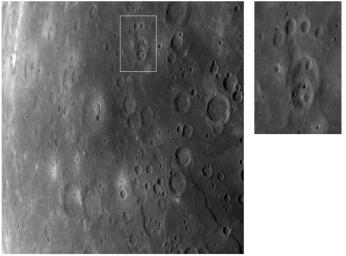
|
Mercury’s Cratered Surface and the “Paw Print”
- Click the image above for a larger view
- Full-Res JPEG (2465 x 1823) (280.8 kB)
- Full-Res TIFF (2465 x 1823) (4.5 MB)
Caption:
Mercury's surface is covered with craters in many sizes and arrangements, the result of impacts that have occurred over billions of years. In the top center of the image, outlined in a white box and shown in the enlargement at upper right, is a cluster of impact craters on Mercury that appears coincidentally to resemble a giant paw print. In the "heel" are overlapping craters, made by a series of impacts occurring on top of each other over time. The four "toes" are single craters arranged in an arc northward of the "heel." The "toes" don't overlap so it isn't possible to tell their ages relative to each other. The newly identified pit-floor crater can be seen in the center of the main image as the crater containing a depression shaped like a backward and upside-down comma.
Date Acquired:
September 29, 2009
Image Mission Elapsed Time (MET):
162739761
Instrument:
Narrow Angle Camera (NAC) of the Mercury Dual Imaging System (MDIS)
Resolution:
800 meters/pixel (0.50 miles/pixel)
Scale:
This image is about 820 kilometers (510 miles) wide
Spacecraft Altitude:
31,500 kilometers (19,600 miles)
Background Info:
This image and caption were prepared by MESSENGER Educator Fellows Sally Jensen (Waterville Valley Academy, Campton, NH) and Annette Iwamoto (Searles Elementary School, Union City, CA). For more information on the MESSENGER Educator Fellows program, click here .
These images are from MESSENGER, a NASA Discovery mission to conduct the first orbital study of the innermost planet, Mercury. For information regarding the use of images, see the MESSENGER image use policy .
Cataloging Keywords:
| Name | Value | Additional Values |
|---|---|---|
| Target | Mercury | |
| System | ||
| Target Type | Planet | |
| Mission | MESSENGER | |
| Instrument Host | MESSENGER | |
| Host Type | Orbiter | |
| Instrument | Mercury Dual Imaging System (MDIS) | |
| Detector | Narrow Angle Camera (NAC) | |
| Extra Keywords | Crater, Grayscale, Impact, Water | |
| Acquisition Date | ||
| Release Date | 2009-10-01 | |
| Date in Caption | 2009-09-29 | |
| Image Credit | NASA/Johns Hopkins University Applied Physics Laboratory/Carnegie Institution of Washington | |
| Source | photojournal.jpl.nasa.gov/catalog/PIA12270 | |
| Identifier | PIA12270 | |
